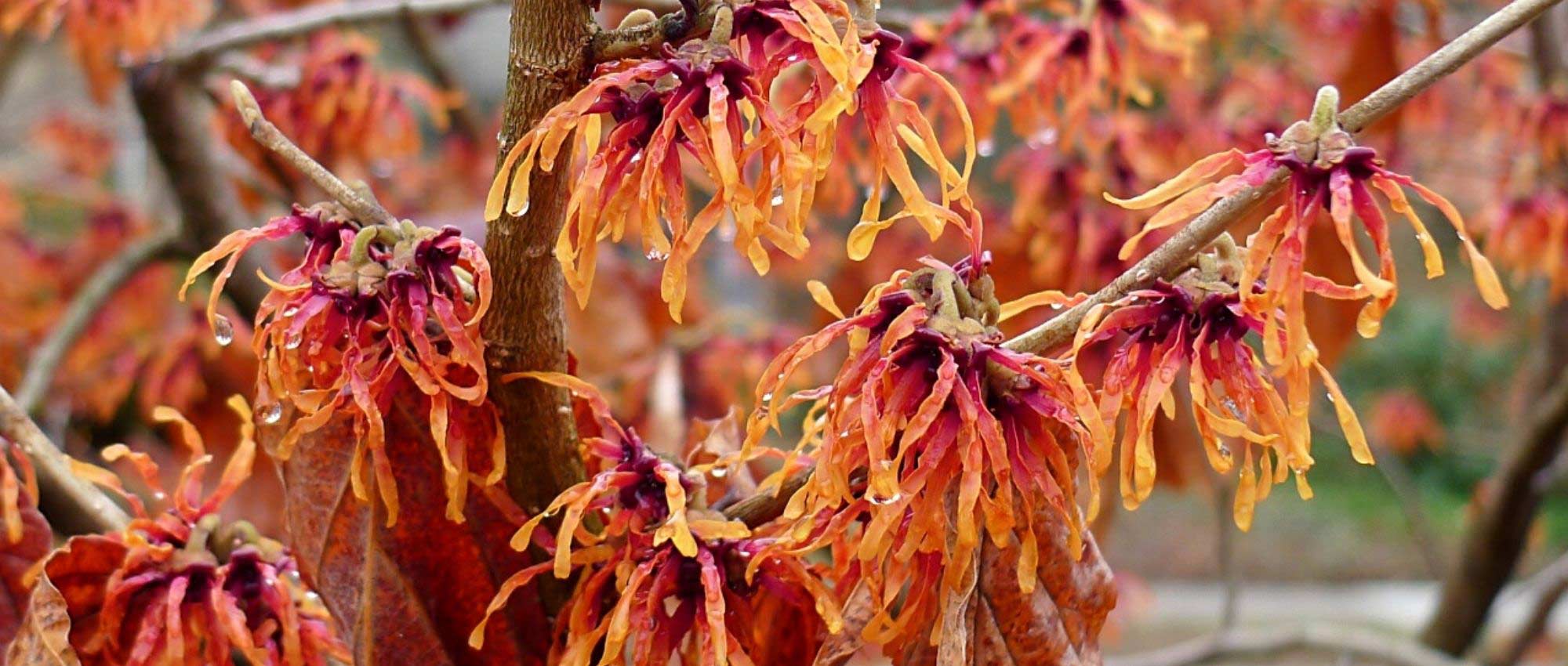
8 bushes with orange flowers you should have in your garden
Discover our selection!
Contents
With their warm colours, orange-flowering shrubs bring a radiant, exotic and invigorating note to the garden. These evergreen or deciduous flowering shrubs break the monotony of green, liven up a dull area of the garden and bring sunshine and light in every season. Their vibrant, warm hues — bright orange, copper, red‑orange or yellow‑ochre — are not reserved for summer alone: Hamamelis flowers warm winter, while those of some brooms, rhododendrons and azaleas add pep to spring. They should be used sparingly so the overall effect remains easy on the eye. They can be paired with bushes with red or purple foliage, or with blue‑flowering plants. They will make other plants stand out or create a flamboyant scene worthy of a Van Gogh painting!
Discover in this fact sheet the most beautiful orange‑flowering bushes that will make your garden shine! And if you would like more options.
Berberis 'Orange King'
Spectacular, this Berberis linearifolia ‘Orange King’ is an evergreen bush that in spring is adorned with bell-shaped flowers, dark orange at opening, then turning to bright light orange and apricot as they fully open. Highlighted by small dark green, glossy and thorny foliage, this sparkling flowering reappears sporadically in summer if soil stays cool. It is followed by red fruits in autumn, making it an interesting bush all year round.
It is a vigorous bush that will reach about 2 m in every direction at ripeness. Undemanding, hardy down to -15°C, it adapts to sun or partial shade, to all our regions and to any sufficiently deep soil, even clay, neither too wet nor excessively dry. It is also little sensitive to pH.
It will fit easily into a mixed hedge, into a border of flowering bushes accompanied by Forsythias or Abelias, in a large rockery, or to cover banks with a creeping cotoneaster. It pairs very well with golden or silver foliage of spindle, or with purple foliage of an Acacia baileyana ‘Purpurea’.
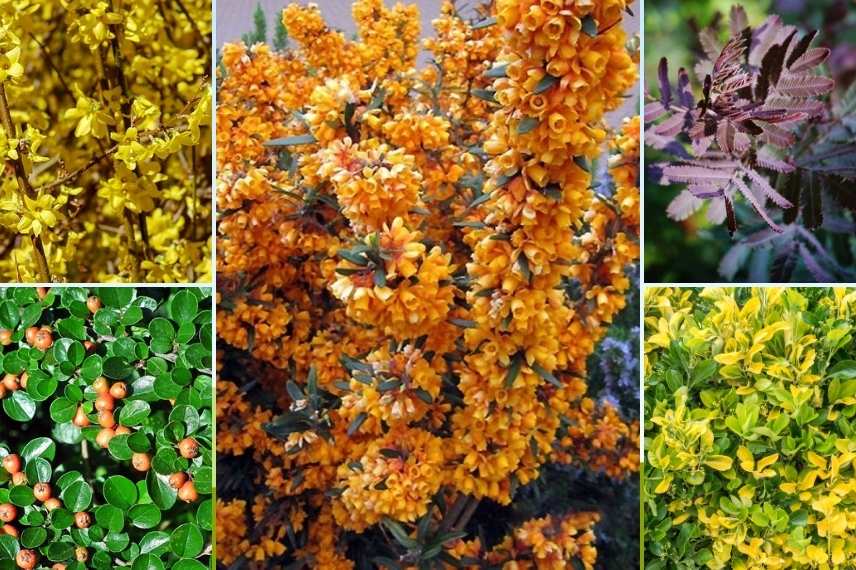
Berberis ‘Orange King’, Forsythia, Cotoneaster, Acacia baileyana purpurea, Variegated spindle
- For more information on these bushes, visit our plant sheet : “Berberis, Thorn barberry : plant, prune and maintain”
-
Discover our wide range of Berberis
Hamamelis 'Jelena'
Hamamelis (x) intermedia ‘Jelena’ is unrivalled for bringing colour sorely missing from the bleak season! Its flowering is deliciously scented and coloured in pale coppery orange, ochre yellow and red, brightening the garden asleep with cold. In the middle of winter, during January and February, the spider-like or clawed flowers, like witch’s fingers, open on the naked branches. It slowly forms an elegant large bush, reaching 4 m in every direction at maturity.
Plant in partial shade in heather soil, or at least in non-calcareous soil. It will be magnificent near the house, under large trees or at the back of a border alongside other bushes with winter flowering, such as Mahonia x media ‘Charity’, or with evergreen bushes such as a camellia. And for a colourful winter garden, pair it with Edgeworthia ‘Red Dragon’ (or paperbush), with ornamental fruit bushes such as ornamental apple trees, and with dogwoods with coloured wood such as Cornus alba ‘Baton Rouge’® or Cornus stolonifera ‘Faviramea’ with yellow bark.

Hamamelis ‘Jelena’ (left), Edgeworthia ‘Red Dragon’ and Mahonia x media ‘Charity’
- Discover our wide range of Hamamelis
Discover other Orange flowering shrubs
View all →Available in 0 sizes
Available in 1 sizes
Available in 1 sizes
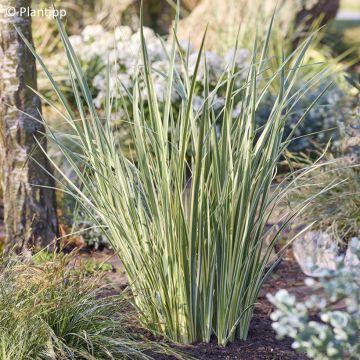
Available in 1 sizes
Available in 1 sizes
Available in 1 sizes
Available in 1 sizes
Available in 2 sizes
Available in 1 sizes
Available in 1 sizes
Japanese quince 'Mango Storm'
We love this much-prized variety for its early flowering at the very end of winter, from March to April! From first fine days, and for around 3 to 4 weeks, Chaenomeles speciosa ‘Mango Storm’ produces a fabulous display of very large camellia-like double flowers, a soft salmony coral orange on still naked, non-thorny shoots. It fits well into a natural garden, even a small one, forming a pretty, very graphic focal point.
This variety tolerates both heat and cold (down to −25 °C) once established, and prefers full sun, in any ordinary, well-drained, rather cool soil.
It will form a rounded bush about 1 m high and wide in a free hedge, at back of border alongside fragrant bushes such as winter honeysuckle and Lilacs, or trained against a wall with winter jasmine, as well as grown as a specimen. It can be combined with other spring-flowering bushes, such as Abeliophyllum distichum and Gordon’s currant, Ribes x gordonianum.
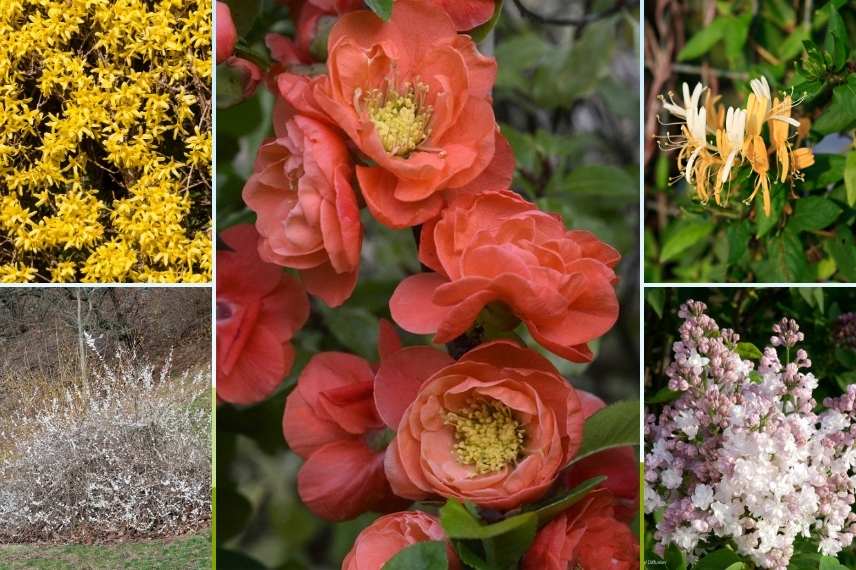
Chaenomeles ‘Mango Storm’, winter jasmine, Abeliophylllum distichum, Lonicera japonica, and Lilac ‘Belle de Moscou’
- Discover our wide range of Japanese quince
Chinese azalea 'Fire Ball'
This heather soil bush is remarkable for its bright orangey-red flowers. In April–May, Azalea ‘Fire Ball’ is smothered in clusters of flowers with an almost exotic exuberance! It is also notable for its coppery foliage from spring to autumn. Vigorous and very frost-hardy, it only requires full sun or partial shade and fresh, light, acidic, lime-free soil. Reaching 1.50 m in height with a 1 m spread, it will slot easily into heather soil borders alongside Pieris, Kalmias, Andromedas and Japanese maples. It will also grow very well in a pot on the terrace or balcony, where it will add a touch of vitality.
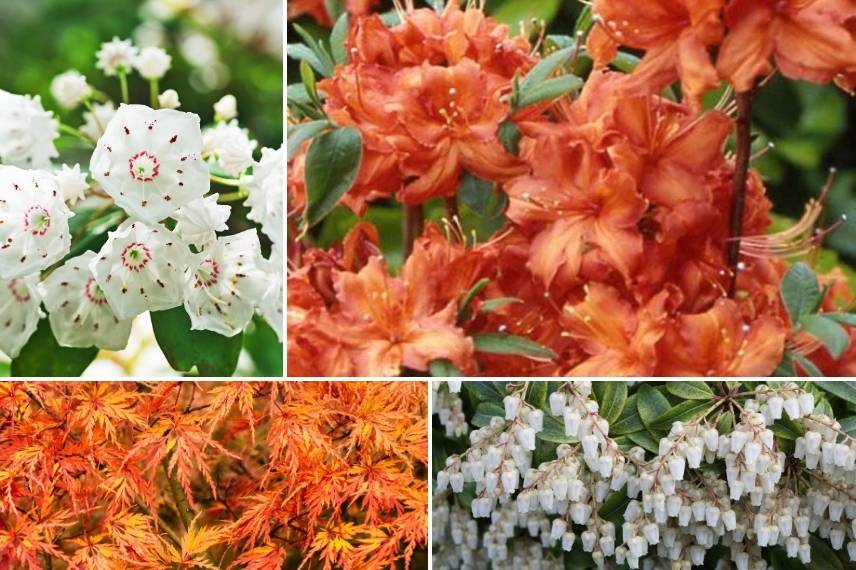
Azalea ‘Fireball’, white Kalmia, Japanese maple and Pieris
- Discover, our wide range of Chinese Azaleas
Cytisus scoparius 'Goldfinch'
Also called “broom”, this deciduous bush offers in late spring an exceptionally abundant, incredibly luminous and scented flowering. From May to June its delicate shoots are covered with pea-like flowers yellow‑orange with red on the outside. With its attractive, airy silhouette, ‘Goldfinch’ has its place in all natural and wild gardens where it will bring a vitamin boost and provide light and movement. Plant it within a flowering hedge, a large bed of bushes or a sunny rockery. With its modest pruning – 1 m high for 1.50 m spread – it can serve as focal point in centre of a small garden or in a pot on a terrace.
Hardy down to -15°C, it grows in sun in all types of soil, preferably slightly acidic. Broom is perfect in a low‑maintenance garden.
It will make a striking display with all warm shades such as peach or apricot of perennials with low habit like helianthemums, potentillas or geums, and will herald staggered flowering of forsythias, ceanothes and buddleias. It pairs well, by contrast, with many bushes with striking purple foliage, such as smoke trees, for example Cotinus coggygria ‘Royal Purple’. Its light branches will stand out well against an evergreen background of conifers.
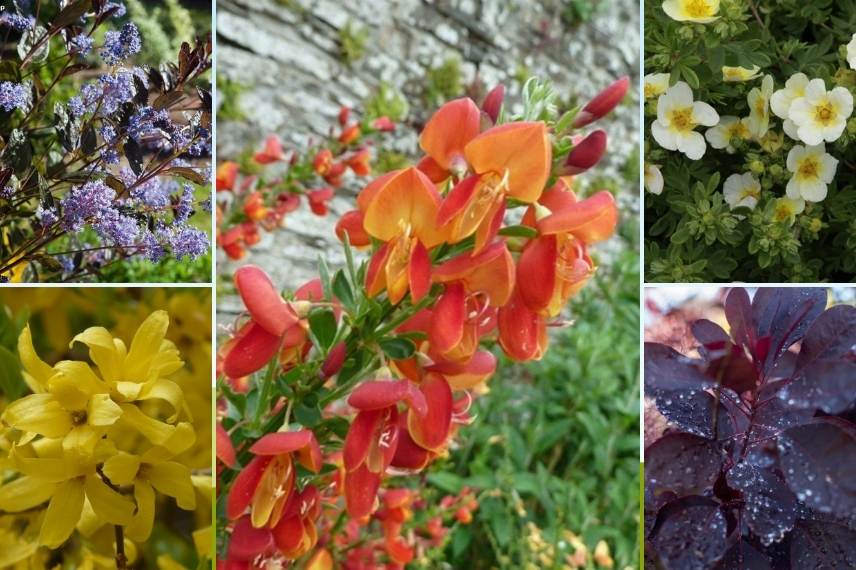
Cytisus scoparius ‘Goldfinch’, Ceanothe ‘Tuxedo’, Forsythia, Potentille fruticosa ‘Limelight’, Cotinus
- Discover our brooms.
Shrubby potentilla 'Hopley's Orange'
This charming flowering shrub with deciduous foliage bears a generous display of bright orange flowers, which will colour gardens, terraces and balconies from summer until first frosts. Its delicate flowers, resembling small wild roses and of vivid hue, bring a very cheerful touch to flower beds, rockeries, borders, low hedges, or containers. They become yellow‑orange at height of summer.
Very easy to grow, Potentilla fruticosa ‘Hopley’s Orange’ appreciates being planted in sun or partial shade, and in ordinary, very well‑drained soil where water does not stagnate.
Compact, it adapts to all gardens and thanks to its rapid growth, is useful for creating an instant garden.
In colourful pit, it will shine in combination with Mediterranean plants (Lavender, Rosemary, Cistus, Fennel, Pittosporum), creating a warm, scented atmosphere. It mixes with all types of summer‑flowering bushes such as buddleias, lavateras, or hibiscus.
In a sunny composition, it will accompany perennials for full sun and add volume to a border alongside Achillea millefolium, Dahlias, Rudbeckias and Kniphofias.
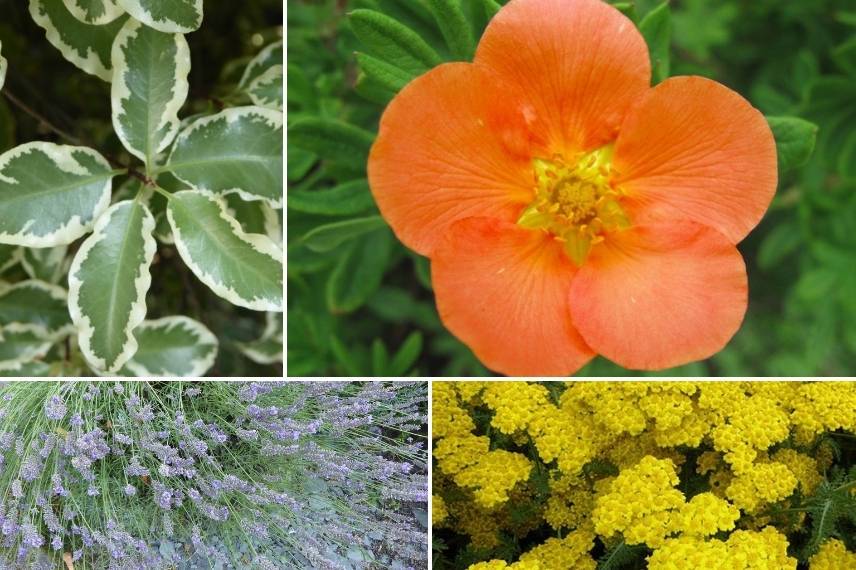
Potentilla ‘Hopley’s Orange, Pittosporum variegatum, Lavender, Achillea hybrid ‘Little Moonshine’
- Discover our wide range of potentillas
Rhododendron 'Olga'
This beautiful variety is prized for its flowers in soft, warm shades of bright orange, the upper part delicately speckled with red. With its flowers gathered in clusters of 3 to 6 in a swirl, rhododendron ‘Olga’ will brighten a bank or rockery when planted with heathers, an Azalea mollis ‘Glowing Embers’ and a Japanese maple, in a harmonious colour scheme.
It forms a bush with a rounded habit about 1 m high and wide, and is equally at home in a border in the garden or in a container on the patio.
Hardy to -12°C, it favours sunny or part-shade positions. Like all rhododendrons, it is a bush for heather soil that prefers non-calcareous, fresh, humus-bearing, well-aerated, slightly acidic soil.
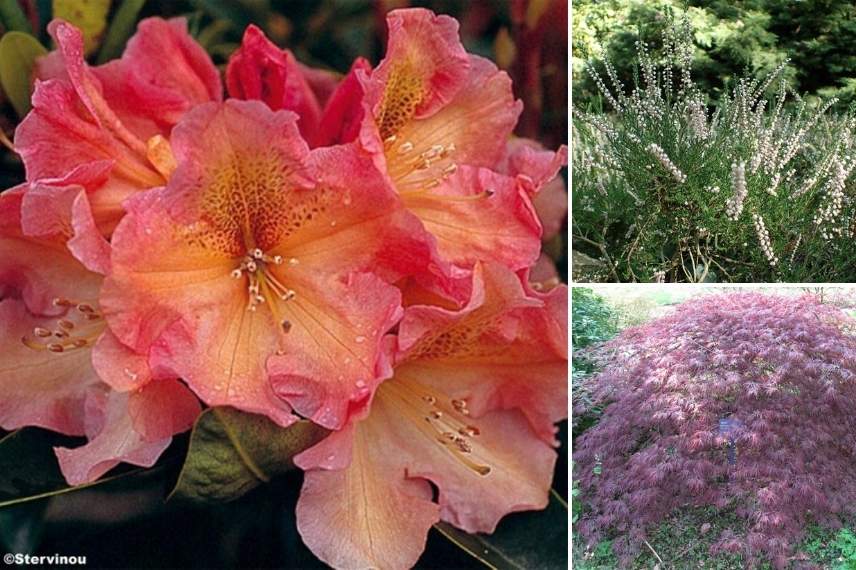
Rhododendron ‘Olga’, Calluna vulgaris Alba, Acer palmatum Ornatum
Sesbania punicea
Better known as pea tree, sesban, or scarlet wisteria, this small tree related to cytisus is floriferous and highly ornamental. It charms with a spectacular summer flowering made up of pea-shaped flowers 2–2.5 cm long in a lovely orange tending towards red, a bright yet gentle hue.
With very rapid growth, it reaches adult size in 2–3 years, about 2.5 m tall by 1.5 m across.
Its striking summer flowering makes it one of the most beautiful bushes in gardens of mild climate. Not very hardy, it is grown in the ground only around the Mediterranean and in the south-west of our country; elsewhere it is best kept in a large pot and overwintered.
It adds an exotic touch to garden or terrace. It is magnificent planted in a mixed border with Caesalpinia gillesii, another small flamboyant with strong exotic appeal, with tritomas or with a Bignonia ‘Madame Galen’ whose trumpet flowers are a warm, luminous orange.
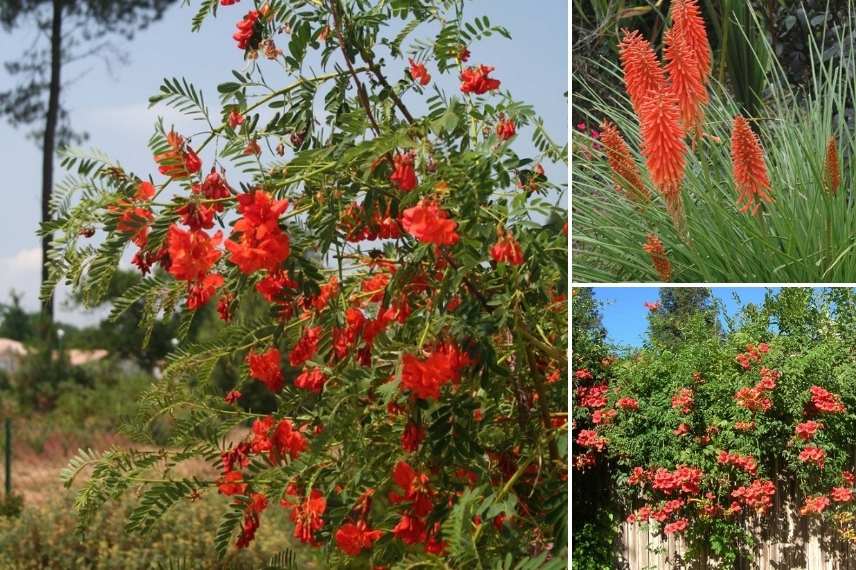
An orange harmony with Sesbania punicea, a tritoma (Kniphofia ‘Nancy’s Red’) and a Bignonia ‘Madame Galen’
- Subscribe!
- Contents
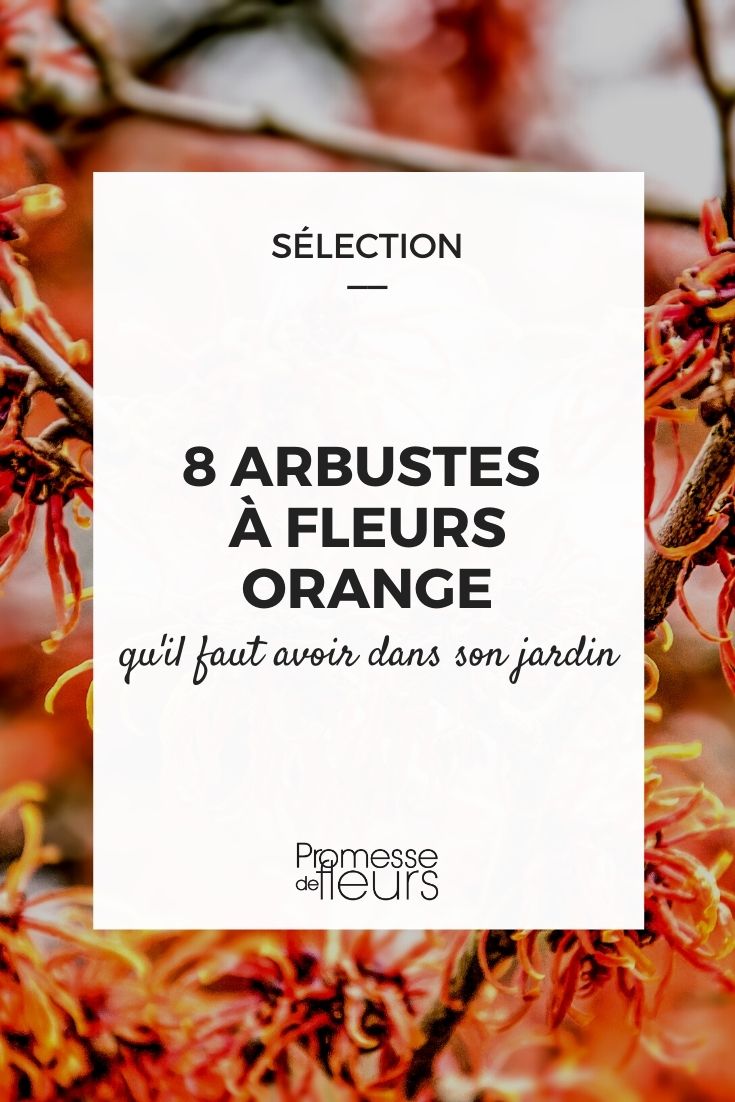

































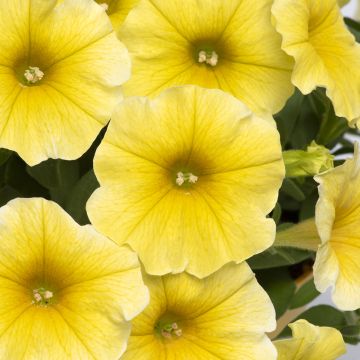
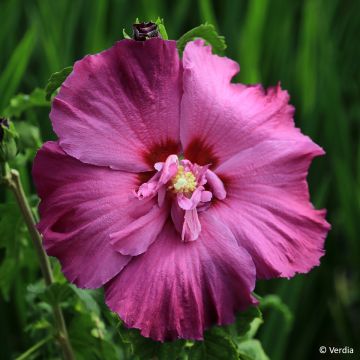
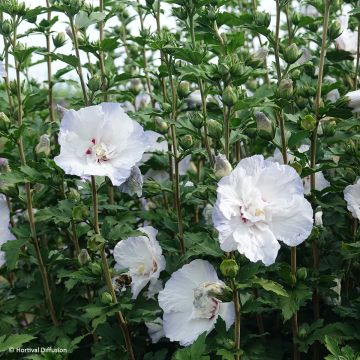


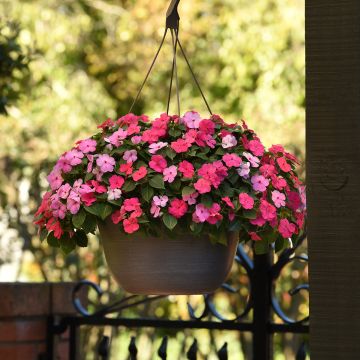
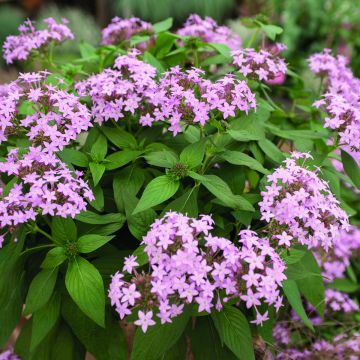
Comments